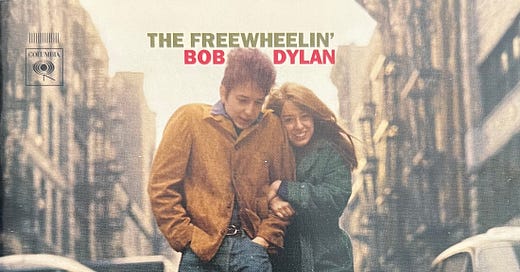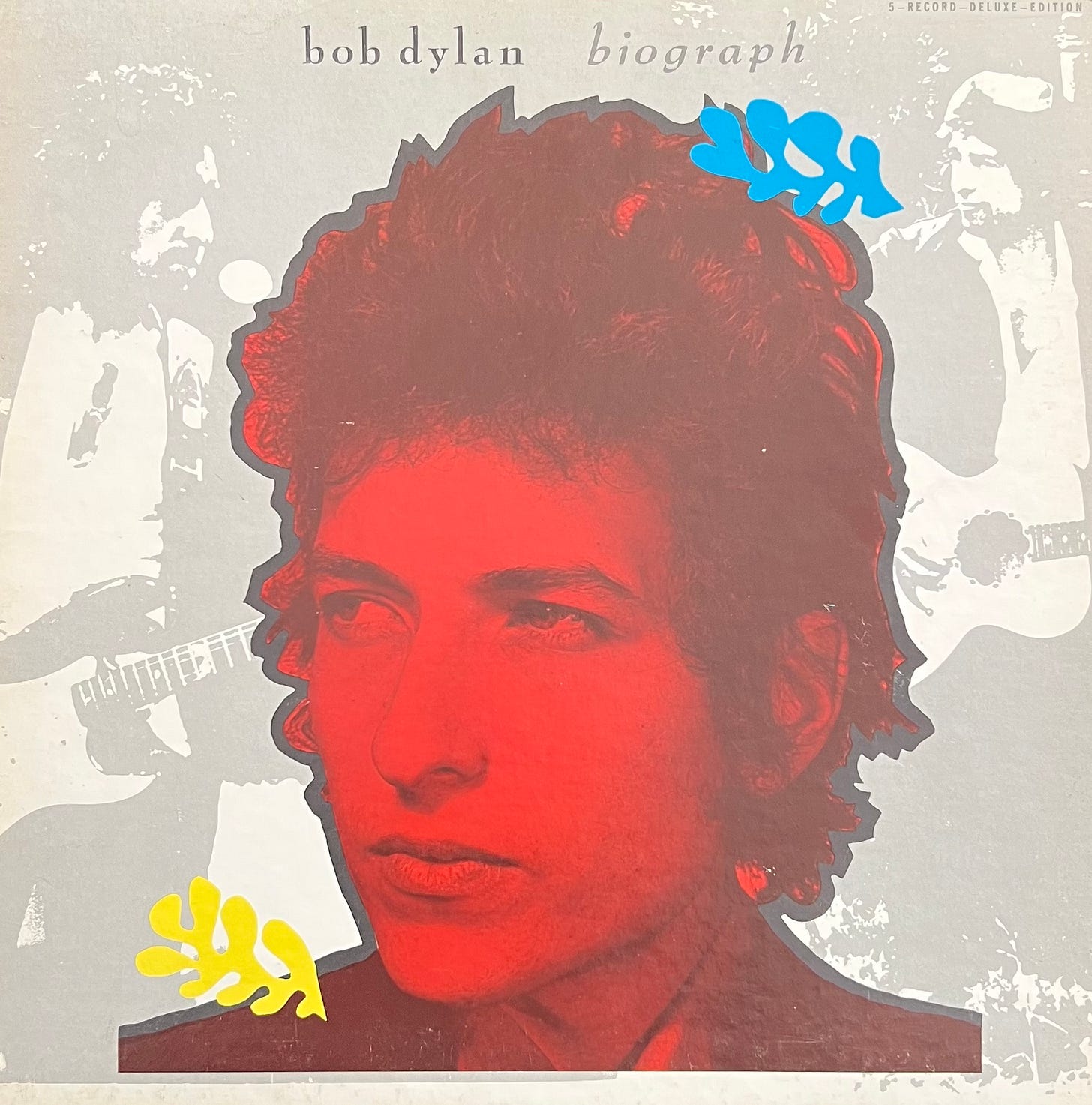Side A Song 5 - A Hard Rain's A-Gonna Fall, Bob Dylan
On Christmas Day I saw the Bob Dylan biopic, A Complete Unknown. As a Dylan fan of many years, I quite enjoyed it as I had expected that I would. My introduction to Dylan was through various songs heard on the radio back in the day, but it wasn’t until the release of the boxed set, Biograph, that I really started to get deeper into the Dylan catalog where I was mesmerized by Visions of Johanna. I was never one to really be bothered by Dylan’s voice like many folks. I find that Dylan’s voice serves the song. And with Dylan, it’s really the messages in the songs that matter.
That brings us to this installment of Side A Song 5 - A Hard Rain’s A-Gonna Fall, the last song on Side A of The Freewheelin’ Bob Dylan. This is Dylan’s second album and the first with a majority of his own compositions. This time period and much of the material is the subject of A Complete Unknown so these songs should be familiar even to the newcomers. The album contains the Dylan classics Blowin’ in the Wind, Girl from the North Country, Masters of War, Don’t Think Twice It’s All Right, and A Hard Rain’s A-Gonna Fall.
Hard Rain is the last song on side A - the sixth song on the album. The song clocks in at just under seven minutes and is one of his most lyrically complex. As with many of Dylan’s songs, interpretation is often less than straightforward and even the “best” intepretations Dylan may dispute. Such is the most obvious interpretation of the Hard Rain. Given the events of the days in the early 1960s, many thought the Hard Rain symbolizes nuclear fallout from a nuclear war between the US and the Soviet Union. But Dylan dismissed this as too narrow.
While the song grew from the turmoil of the postwar period of the early 1960s, there is much to be related to the events of our current time. The “blue-eyed son” feels very much like a prophet who has been on a journey ahead and is asked to relate what he saw and heard as if he has seen a future and has come to warn of a coming hard time.
I’ve stumbled on the side of twelve misty mountains
I’ve walked and I’ve crawled on six crooked highways
I’ve stepped in the middle of seven sad forests
I’ve been out in front of a dozen dead oceans
I’ve been ten thousand miles in the mouth of a graveyard
It’s not hard to read these lyrics today and think of the impacts of climate change on our environment, particularly when you read of warming of the oceans and the death of large coral reefs. Thinking of the current wildfires in California, the hurricanes of the past summer, the floods that killed many in Pakistan last year, and the growing droughts across many parts of the planet, it is hard not to think that we are standing at the mouth of our own graveyard with our graves dug with our own hands.
I saw a newborn baby with wild wolves all around it
I saw a highway of diamonds with nobody on it
I saw a black branch with blood that kept drippin’
I saw a room full of men with their hammers a-bleedin’
I saw a white ladder all covered with water
I saw ten thousand talkers whose tongues were all broken
I saw guns and sharp swords in the hands of young children
The rise of the far right across the West with more and more power concentrated in the hands of a few oligarchs are today’s wild wolves that are threatening established as well as baby democracies. The bleeding hammers are the current information platforms that are used to spread disinformation and division creating an evironment where the peacemakers and voices of freedom seem to be “all broken” because they go unheard.
I heard the sound of a thunder, it roared out a warnin’
Heard the roar of a wave that could drown the whole world
Heard one hundred drummers whose hands were a-blazin’
Heard ten thousand whisperin’ and nobody listenin’
Heard one person starve, I heard many people laughin’
Heard the song of a poet who died in the gutter
Heard the sound of a clown who cried in the alley
The last ten years there has been a thunder roaring that we perceived to be off in the distance, a coming wave that could indeed “drown the whole world.” For whatever reasons, not enough people have been listening to the “ten thousand whispering.” It feels very much like we have devolved into a society that would rather laugh at the starving rather than build a connected community that focuses on a more peaceful and sustainable world.
I met a young child beside a dead pony
I met a white man who walked a black dog
I met a young woman whose body was burning
I met a young girl, she gave me a rainbow
I met one man who was wounded in love
I met another man who was wounded with hatred
In the midst of all of the despair around, in this verse there are signs of hope - a girl who gave a rainbow, and white man who walked a black dog. In the midst of a storm, there’s a rainbow and at the end a future of harmony, but only if we choose it.
The ending of the song is the guidepost we need. The question is, “what are you going to do?” We all need to think about our circumstances and our abilities and answer that question accordingly.
Oh, what’ll you do now, my blue-eyed son?
Oh, what’ll you do now, my darling young one?
I’m a-goin’ back out ’fore the rain starts a-fallin’
I’ll walk to the depths of the deepest black forest
Where the people are many and their hands are all empty
Where the pellets of poison are flooding their waters
Where the home in the valley meets the damp dirty prison
Where the executioner’s face is always well hidden
Where hunger is ugly, where souls are forgotten
Where black is the color, where none is the number
And I’ll tell it and think it and speak it and breathe it
And reflect it from the mountain so all souls can see it
Then I’ll stand on the ocean until I start sinkin’
But I’ll know my song well before I start singin’
And it’s a hard, it’s a hard, it’s a hard, it’s a hard
It’s a hard rain’s a-gonna fall
It’s up to us to go out in the communities we live and speak truth to power. In an interview with Studs Terkel, Dylan said that "‘the pellets of poison are flooding the waters’, that means all the lies that people get told on their radios and in their newspapers.” (Cott, Jonathan, ed. (2006). Dylan on Dylan: The Essential Interviews. Hodder & Stoughton. ISBN 0-340-92312-1.) These days, it’s the lies we are told on social media and television. The “executioner’s face” is the algorithm that drives outrage and disinformation. It’s up to us to “tell it and think it and speak it and breath it,” to “reflect it from the mountain so all souls can see it.” We have to fight the lies and disinformation with truth and justice.
Hard Rain is an excellent Side A Song 5. It’s a song of hope in a valley of despair and a call to action. Why would you not want to turn the album over to see what inspiration lies in the songs on the other side?
I can’t begin to know what was in Dylan’s mind at the time he wrote this masterpiece and I was not alive to experience the times. My appearance came just after. But Hard Rain is still relevant today and these are my thoughts on what we can take away from this timeless classic. Share your thoughts and interpretations in the comments below. Please share with music lovers and anyone you think might enjoy this little series. Thanks!




